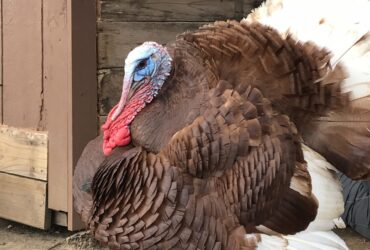
Tips + Tricks
Turkeys vs. Chickens – Top 3 Differences
As an Amazon Associate I earn from qualifying purchases.
Since our main farm focus is raising heritage turkeys, people often ask me how turkeys differ from chickens. I consider chickens to be the gateway farm animal. Many homesteaders and beginning farmers start out with a few chickens because they are so accessible and can be raised simply. So how different is raising a heritage turkey? Here are my top 3 differences between raising heritage turkeys and chickens.
Disclaimer: My experience comes from raising heritage turkeys, not commercial meat turkeys. Meat turkeys (broad breasted varieties) are very different!
1. Turkeys will roost anywhere except where you want them to.
We started with 2 heritage turkeys incorporated into our mixed flock of chickens, and while they were young, the turkeys acted essentially the same as the chickens. They would go in the coop at night with no problems and roost with the chickens. But something in them changed as they got older. One night when I was closing up the coop I didn’t see them in their usual spots.
Then, I looked high above the coop and spotted our 2 turkeys roosting in a tree branch. There was no way I was getting them down. The constant battle to get the turkeys to sleep inside the coop had begun. Even through wind and rain, the turkeys preferred to roost in the trees, as they would in nature. I would go out to the coop before dark and try to herd them onto the proper roosts only to have them dart by me and jump into the trees.

Heritage turkeys descend from wild turkeys, and you can really tell they still have a lot of their natural instincts embedded in their brains! Instead of sleeping in a small closed in box, they would rather be high up in the trees, free to escape from any potential dangers.
The solution:
When we made the decision to focus on raising turkeys, I knew we would have to build them a roost in the pasture that they would actually use. There are trees nearby, and the last thing I wanted was for the turkeys to leave the safety of their electric netting to sleep in a tree.
(Link to the AWESOME electric netting we use here!)
I had seen a few pastured turkey roost ideas on Google, but the designs that stood out to me were tall, with lots of “branches”. Almost like a fake tree with lots of easy roosting spots. We wanted to make it as attractive to the turkeys as possible.
We cemented (2) 12 foot wooden posts into the ground and added several 2 x 4’s sticking out off the main post. It kind of looks like an old-school TV antenna with many prongs coming off it. And guess what, the turkeys love it! The first night it was up, all the turkeys instinctively flew up onto the tall, easily accessible roost.

2. Turkeys eat more and need higher % protein.
It’s not surprising that a 25 lb tom turkey will need more food than a chicken. Watching scoop after scoop of food disappear can be eye opening! My turkeys eat like they haven’t eaten in 5 days. They take massive gulps of food and before I know it, the feeder is empty!
Turkey poults should be fed a higher protein feed than chicks, too. That’s something I’ve run into a few times where I want to brood turkeys and chicks together, but don’t know how to feed them separately. My solution is pretty simple: don’t brood them together hahah.

It’s recommended that turkeys eat 28% protein feed for at least the first 6 weeks. That’s quite the difference from your standard chick starter that is usually 18-20%. This feed will be more expensive as well.
Once the turkeys are full grown, I like to feed them a 20% protein crumble. Purina Flock Raiser is an excellent product that I’ve used to feed my mixed flock of turkeys, ducks, and chickens.
3. Turkeys are friendlier than chickens!
This is the main reason I decided I wanted to focus on turkeys over chickens. They are curious, funny, easy-going, and friendly. They will follow you around and watch your every move. Yes, chickens and ducks can be friendly too, but in my experience the turkeys without fail are even friendlier!
When my turkeys see me coming, they start calling for me then chase me along the fence. This also comes in handy if you have escapees. Have you ever tried herding a bunch of chickens? IMPOSSIBLE. They run every which way and avoid you like the plague.
When I have turkeys that have hopped the fence, I simply walk over to them and they follow behind me back to the entrance of their netting.
Conclusion?
Heritage turkeys are an awesome addition to the small farm or homestead. They are beautiful to watch and are always the center of conversation when visitors arrive. With just a few small adjustments, raising turkeys isn’t much harder than chickens. Just be prepared for their quirky sleeping habits!











4 Comments
Gloria Fernandez
This was very interesting. Now, I’m tempted to consider turkeys. 🙂
admin
They’re so fun! Thanks for reading!
Jamie
We raise heritage breed Royal Palm turkeys mostly to sell their chicks and eggs. People where we live baulk at our prices ($10 per chick) but then everyone here seems to always want something for nothing. I think they forget two things: heritage breed turkeys are NOT broad breasted turkeys and that locally hatched chicks have far better survival rates than mail order chicks (which would cost them nearly double anyway).
admin
I hear ya. We sell our heritage poults for $15!